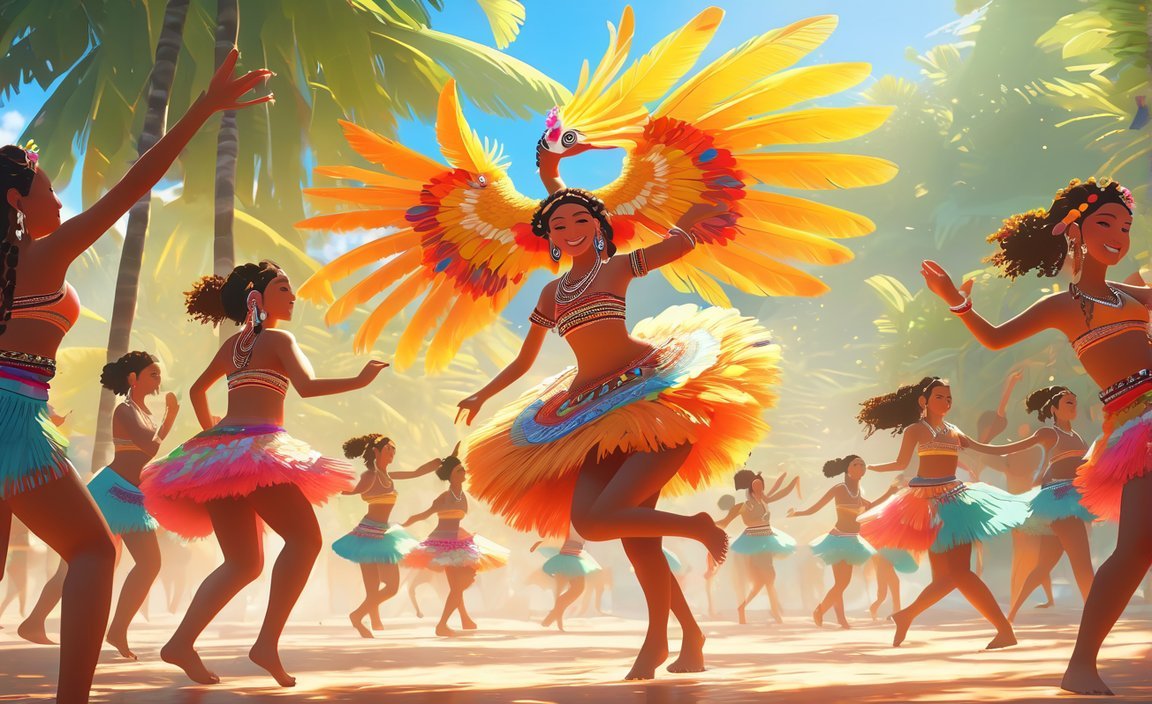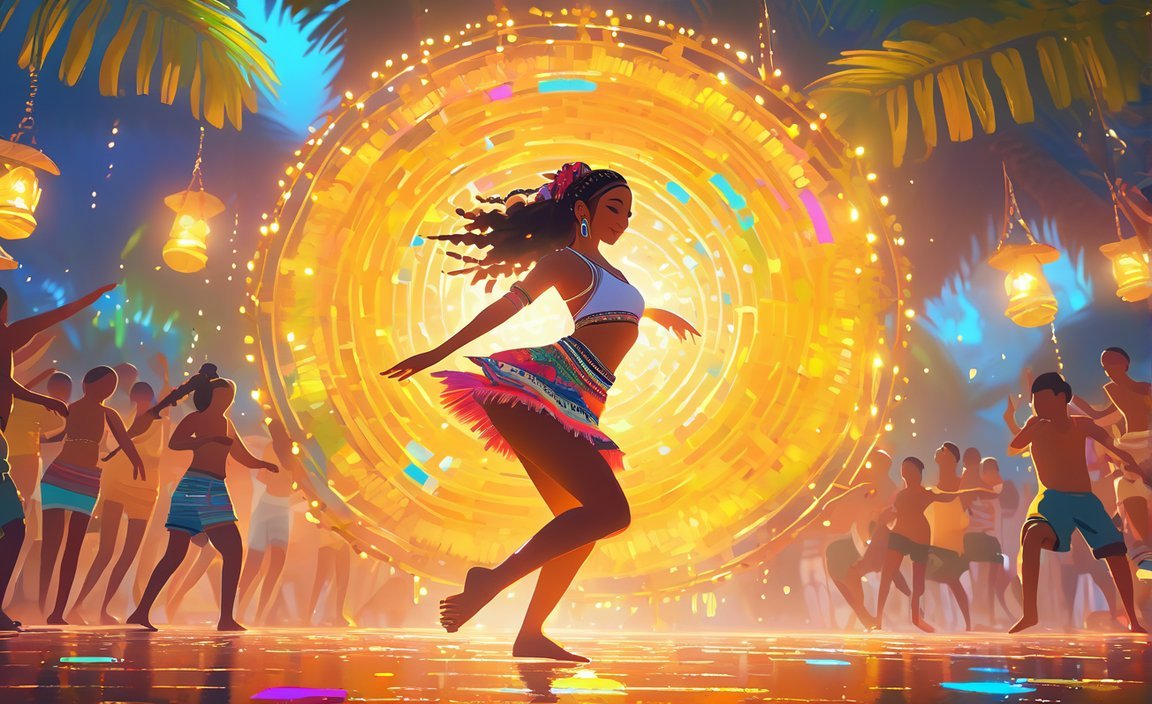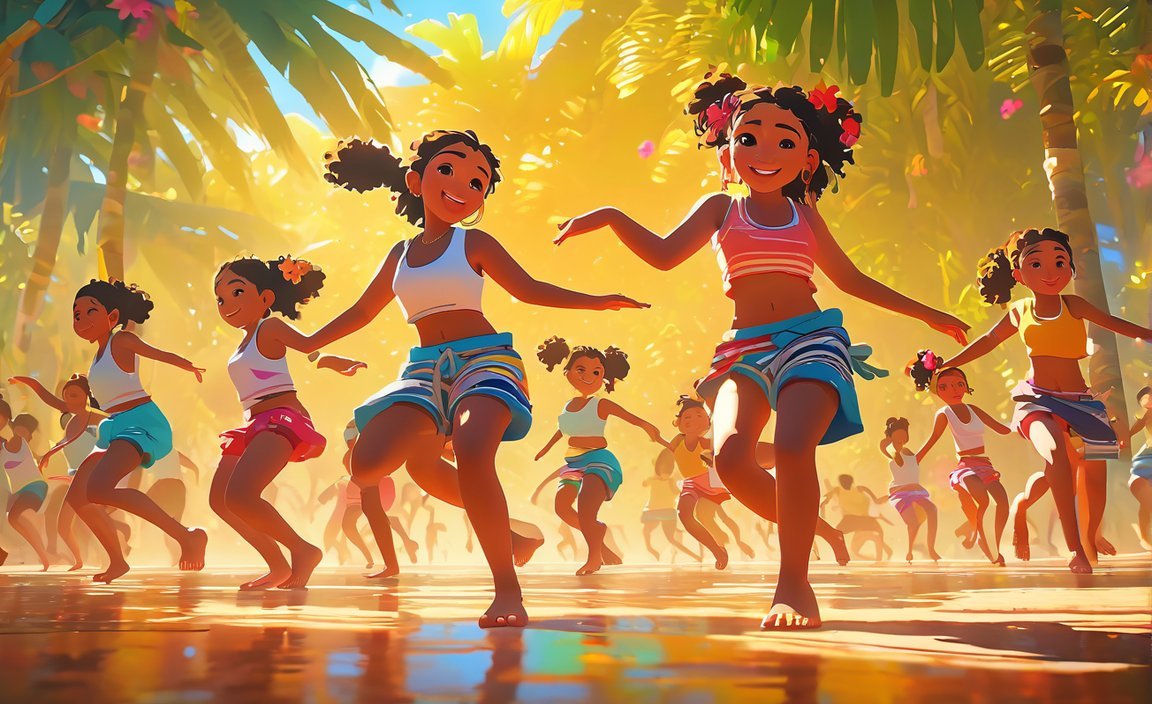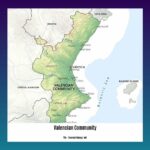Unveiling the Vibrant Story of Honduran Punta Dance takes us on a captivating journey into the heart of one of Honduras’ most cherished cultural traditions. This enchanting dance form, deeply rooted in the country’s rich history and heritage, has been captivating audiences for generations with its mesmerizing rhythms and vibrant movements. From its origins in the Garifuna community to its contemporary developments, Punta dance stands as a vibrant testament to the resilience and creativity of the Honduran people. In this article, we delve into the historical significance, influences, and evolution of Punta dance, shedding light on its unwavering role in Honduran culture.

Key Takeaways:
- The Punta dance is a traditional dance belonging to the Garifuna community.
- It is also known as banguity or bunda.
- The dance has Afro-indigenous origins and incorporates elements of African and Arawak cultures.
- The Punta dance originated from the Garifuna people in Saint Vincent and the Grenadines.
- The Garifuna people were later exiled from the island.
- Punta dance is popular in Belize, Honduras, and other Caribbean islands.
- Punta dance is characterized by fast-paced movements and energetic rhythms.
- It is often performed at cultural events, parties, and family gatherings.
- The dance is accompanied by Punta music, which is a unique genre that originated in Honduras.
- Punta music is a mix of African and Caribbean influences.
- Traditional Punta dance costumes are colorful and vibrant.
- Punta dance is an important part of Garifuna culture and heritage.
Punta Dance in Honduras
Unveiling the Vibrant Story of Honduran Punta Dance
Introduction
In the colorful tapestry of traditional dances around the world, there exists Punta dance — a rhythmic and energetic spectacle that holds deep cultural significance for the Garifuna community in Honduras. With its Afro-indigenous origins rooted in the rich histories of African and Arawak cultures, Punta dance has captivated audiences with its mesmerizing rhythms and vibrant movements. In this article, we will delve into the captivating world of Punta dance in Honduras, exploring its historical significance, influences, and contemporary developments.
Historical Significance and Origins
The story of Punta dance begins with the Garifuna people, whose ancestral roots lie in Saint Vincent and the Grenadines. The dance was an integral part of their expressive cultural heritage. However, the Garifuna people faced a tumultuous history, marked by exile from their homeland. In the late 18th century, they were forcibly deported to Central America, including Honduras. Despite these challenges, the Garifuna community tenaciously preserved their traditions, including the vibrant Punta dance.
Cultural Significance
Punta dance holds immense cultural significance for the Garifuna people in Honduras. It is cherished as a celebration of their Afro-indigenous heritage and serves as a powerful means of passing down cultural traditions from one generation to another. The dance is an integral part of various cultural events, parties, and family gatherings, where its lively and infectious rhythms fill the air. Punta dance serves as a unifying force, bringing together individuals from diverse backgrounds to celebrate the shared cultural tapestry of Honduras.
Influences and Contemporary Developments
Punta dance is a beautiful amalgamation of African and Caribbean influences, reflected not only in its movements but also in the accompanying music. Punta music, a unique genre that originated in Honduras, blends African drumming rhythms with distinctive Caribbean melodies. Over the years, Punta dance has evolved, incorporating contemporary elements while staying true to its traditional roots. Today, it continues to thrive and captivate audiences not only in Honduras but also in neighboring Belize and other Caribbean islands.
The Enchanting Moves and Vibrant Costumes
Punta dance is renowned for its fast-paced movements and the contagious energy it exudes. Dancers skillfully maneuver their bodies, punctuating the air with swift turns, hip gyrations, and intricate footwork. The dance requires agility and precision, as performers synchronize their movements with the vibrant Punta music.
To complement the vivacious dance style, traditional Punta dance costumes are a sight to behold. Bursting with color and intricate designs, these vibrant costumes feature elaborate headdresses, fringed skirts, and adorned tops. Each element of the traditional attire reflects the cultural values and history of the Garifuna people.
In Conclusion
As we immerse ourselves in the enchanting world of Punta dance in Honduras, it becomes evident that this dance style is not merely a form of artistic expression; it is a testament to the resilience and cultural pride of the Garifuna community. From its Afro-indigenous origins to its contemporary developments, Punta dance continues to captivate audiences with its pulsating rhythms and vibrant movements. So next time you witness the mesmerizing grace of Punta dance, allow yourself to be transported on a captivating journey through the rich cultural tapestry of Honduras.
Charles Darwin grave – Explore the final resting place of the legendary scientist and visionary, Charles Darwin. Discover the significance of his grave and delve into the profound impact he had on the field of evolutionary biology.
Guatemala national anthem song – Immerse yourself in the rich cultural heritage of Guatemala while listening to the soul-stirring melodies of the national anthem song. Experience the vibrant traditions and patriotic spirit of this enchanting Central American country.
Interesting facts in Spanish – ¿Quieres descubrir datos fascinantes en español? Haz clic en este enlace y sorpréndete con curiosidades alucinantes que te dejarán con la boca abierta. No puedes perderte esta oportunidad de ampliar tus conocimientos de forma divertida y educativa.
Makkah Royal Clock Tower – Behold the majestic Makkah Royal Clock Tower, a towering symbol of Islamic architecture and engineering marvel. Click here to learn more about this iconic structure and its significance in the heart of Mecca.
Errors are not in the art but in the artificers – Dive into the enchanting world of art and discover the profound truth behind the saying “Errors are not in the art but in the artificers.” Uncover the hidden messages and deeper meanings that lie within artistic creations by exploring this captivating link.
Basic Steps and Posture in Punta Dance
In the mesmerizing world of Punta dance, every step and movement tells a captivating story of cultural heritage and celebration. If you’re eager to unveil the secrets of this vibrant dance style from Honduras, get ready to explore the basic steps and posture that make Punta dance so unique.
The Afro-Indigenous Origins
Punta dance is Afro-indigenous, blending elements of African and Arawak culture and terpsichorean traditions. Originating from the Garifuna people of the Caribbean island country of Saint Vincent and the Grenadines, Punta dance is deeply rooted in their cultural history. In the traditional Garifuna culture of Honduras, the dance is also known as “banguity” or “new life.”
The Rhythmic Circle
The social dance begins with spectators forming a circle around a male and a female dancer who face off against each other. As the ancient beats of the drums resound in the air, the dancers come alive, moving with grace and passion.
The Call and Response
Punta dance music is famous for its call-and-response pattern. The drummers strike a rhythm, and the dancers respond with their movements, creating a harmonious conversation between the dancers and the music.
The Sensual Movements
Now, let’s dive into the heart of Punta dance – the basic steps and posture. The name “Punta” is derived from the West African word “bunda,” which means “buttocks.” The dance is characterized by rapid movements of the buttocks, hips, and feet, while the upper torso remains motionless. It’s a dance that requires control, agility, and a deep connection to the rhythms of the music.
Mastering the Basics
To master the basic steps of Punta dance, you’ll need to focus on your lower body movements. Stand with your feet slightly apart, ready to embrace the pulsating rhythms. As the music drives you, start by shifting your weight from one foot to the other, engaging your hips and allowing them to sway with the beat. Feel the energy of the dance flowing through your body, igniting every movement.
Posture and Elegance
While the focus is on the lower body, maintaining an elegant posture is essential in Punta dance. Keep your upper body upright, with your shoulders relaxed and your chest open. As you move your hips and feet, let your arms gently flow with the rhythm, adding a touch of grace to your dance.
Embrace Cultural Expression
Punta dance isn’t just about mastering the steps and posture; it’s about immersing yourself in the rich cultural expression of the Garifuna people. Traditional Punta dance costumes are vibrant and feature elaborate headdresses, fringed skirts, and adorned tops. These costumes represent the cultural pride and heritage of the Garifuna community.
So, as you step into the world of Punta dance, remember that it’s not just about the movements – it’s about embracing the spirit, history, and cultural significance behind each step. Let the rhythms guide you, and the dance will come alive, revealing the vibrant story of Punta dance from Honduras.
Key Takeaways:
– Punta dance is an Afro-indigenous dance form originating from the Garifuna people in Saint Vincent and the Grenadines.
– The dance is also known as “banguity” or “new life” in the traditional culture of Honduras.
– Dancers participate in a social dance where they face off against each other in a rhythmic circle.
– Punta dance music is famous for its call-and-response pattern and is accompanied by drums.
– The basic steps involve rapid movements of the buttocks, hips, and feet while maintaining an elegant posture.
– Traditional Punta dance costumes are vibrant and symbolize the cultural pride and heritage of the Garifuna community.
Sources:
– City Dance. “What Is A Punta Dance? Where Does Punta Dance Come From?” source.
– World-wide Dances. “Punta Dance – World-wide Dances.” source.
Traditional costumes and accessories in Punta dance
The Punta dance is not only a celebration of Afro-indigenous culture but also a visual spectacle that showcases traditional costumes and accessories. These elements play an essential role in enhancing the beauty and cultural significance of the dance. Let’s delve deeper into the vibrant world of Punta dance costumes and accessories.
Traditional Costumes:
The costumes worn by Punta dancers are a testament to the rich cultural heritage of the Garifuna people. Both male and female dancers have their unique traditional attire that adds to the overall visual appeal of the dance.
Male Dancers:
Male dancers in Punta dance performances often wear colorful tops that cover most of their upper body. These tops are adorned with intricate patterns and designs that reflect the cultural motifs and symbols of the Garifuna community. Underneath these tops, they usually wear soft and lightweight underclothes to ensure ease of movement during the energetic dance routines.
Female Dancers:
Female dancers in Punta dance showcase their style and grace through their sleeveless tops made from colorful threads. These tops are meticulously crafted with vibrant patterns and embroidery, representing the cultural identity and heritage of the Garifuna people. The designs often incorporate floral motifs that symbolize nature’s beauty and the connection between the Garifuna people and their environment.
Accessories:
To complete their stunning appearance, both male and female Punta dancers adorn themselves with a variety of accessories that add flair and authenticity to their costumes.
Metal Anklets:
One notable accessory worn by male dancers is the metal anklets. These anklets are not only aesthetically pleasing but also have a functional purpose during the dance. They create a rhythmic sound when the dancers move, adding a dynamic and captivating element to the performance.
Headgear:
The headgear worn by male dancers is an essential component of their traditional costume. These headgears are often elaborate and heavily adorned with vibrant colors, feathers, and other decorative elements. They symbolize the cultural pride and heritage of the Garifuna people, creating a striking visual contrast against the dancers’ attire.
Key Takeaways:
- Punta dance showcases traditional costumes and accessories that reflect the cultural heritage of the Garifuna people.
- Male dancers wear colorful tops and lightweight underclothes, while female dancers don sleeveless tops made from colorful threads.
- The costumes feature intricate patterns and designs that represent the cultural motifs and symbols of the Garifuna community.
- Metal anklets worn by male dancers produce rhythmic sounds during the dance, enhancing the energetic and vibrant atmosphere.
- Elaborate and heavily adorned headgears are a prominent accessory in Punta dance, symbolizing cultural pride and heritage.
Sources:
- City Dance
- Encyclopedia Britannica
Contemporary Developments in Punta Dance
The Punta dance tradition in Honduras has deep historical and cultural roots that continue to evolve with the passage of time. While the dance itself remains true to its Afro-indigenous origins, there have been contemporary developments that have influenced its style and presentation. In this article, we will explore some of the notable contemporary developments in Punta dance, shedding light on how this vibrant dance form continues to captivate audiences and adapt to modern influences.
Blending Traditional and Modern Elements
Punta dance has always been a dynamic art form, incorporating influences from African and Caribbean cultures. In recent years, there has been a deliberate effort to blend traditional elements of Punta dance with modern choreography and music. This fusion of styles has created a fresh and exciting interpretation of the dance, appealing to both traditionalists and those seeking a contemporary twist.
Incorporation of Contemporary Music Styles
While traditional Punta dance is accompanied by rhythmic drumming, contemporary developments have seen the introduction of new music styles into the dance. Artists and dancers have embraced genres such as reggae, hip-hop, and electronic beats, infusing them seamlessly into Punta dance routines. This integration of modern music styles adds a layer of versatility and creates a unique fusion of old and new.
Fusion with Other Dance Styles
Another significant contemporary development in Punta dance is its fusion with other dance styles. Choreographers and dancers have been experimenting with blending Punta dance with salsa, jazz, and even modern dance techniques. These collaborations bring diverse movement vocabulary and create exciting hybrid performances that push the boundaries of traditional Punta dance.
Reimagining Traditional Costumes
While traditional Punta dance costumes continue to be worn, contemporary developments have seen reimaginations of these traditional outfits. Designers have incorporated modern fabrics, colors, and patterns to create visually stunning costumes that maintain the essence of Punta dance while embracing contemporary fashion trends. These updated costumes add vibrancy and visual appeal to the dance performances.
Embracing Digital Platforms
The digital age has ushered in new opportunities for the promotion and dissemination of Punta dance. Dancers and dance companies have begun to use social media platforms and online video sharing platforms to showcase their performances and connect with a wider audience. This increased visibility has allowed Punta dance to reach new global audiences and has sparked interest in the dance form outside of its cultural origins.
Key Takeaways:
- Punta dance has embraced contemporary developments while maintaining its Afro-indigenous roots.
- Contemporary Punta dance blends traditional and modern elements, appealing to both traditionalists and those seeking a contemporary twist.
- The incorporation of contemporary music styles has added versatility and innovation to Punta dance performances.
- Fusion with other dance styles, such as salsa and jazz, has expanded the movement vocabulary of Punta dance.
- Reimagined traditional costumes bring a modern aesthetic to Punta dance performances.
- The digital age has provided new platforms for the promotion and dissemination of Punta dance, reaching a wider audience globally.
Citation 1: City Dance – What Is A Punta Dance?

FAQs about the Honduran Punta Dance
Q1: What is the cultural significance of the Punta dance in Honduras?
A1: The Punta dance holds great cultural significance in Honduras as it is deeply rooted in the traditions of the Garifuna people. It serves as a celebration of their heritage and identity.
Q2: How did the Punta dance originate in Honduras?
A2: The Punta dance originated from the Garifuna people in the island country of Saint Vincent and the Grenadines in the Caribbean. The Garifuna people later brought the dance to Honduras and it became an integral part of their cultural expression.
Q3: What are the key elements of the Punta dance costume?
A3: Male dancers in the Punta dance wear colorful tops, metal anklets, and heavy headgear, while female dancers wear sleeveless tops made from colorful threads. The costumes are vibrant and play a significant role in enhancing the visual appeal of the dance.
Q4: How is the Punta dance performed?
A4: The Punta dance is typically performed in a social setting, with spectators forming a circle around a male and female dancer. The dancers face off against each other, showcasing their skill and agility through rapid movements of the buttocks, hips, and feet.
Q5: What type of music accompanies the Punta dance?
A5: The Punta dance is accompanied by Punta music, which is a unique genre that originated in Honduras. The music is characterized by its lively rhythms and call-and-response pattern, often driven by drum beats that pay homage to the dance’s African roots.
- Crypto Quotes’ Red Flags: Avoid Costly Mistakes - June 30, 2025
- Unlock Inspirational Crypto Quotes: Future Predictions - June 30, 2025
- Famous Bitcoin Quotes: A Deep Dive into Crypto’s History - June 30, 2025
















